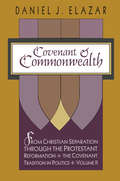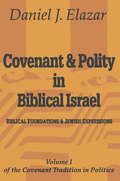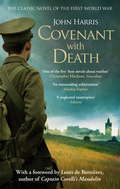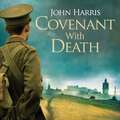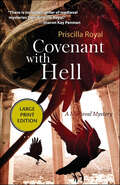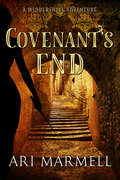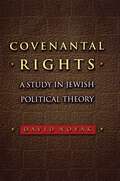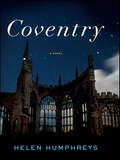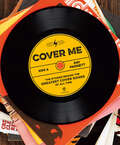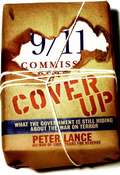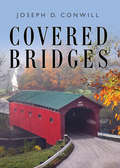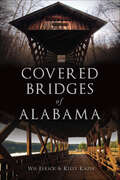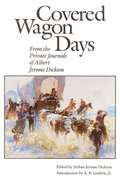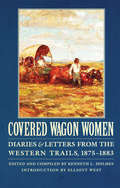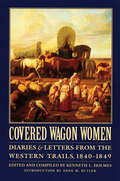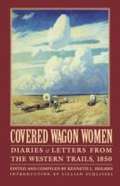- Table View
- List View
Cousteau
by Axel MadsenOne of the most influential men of the twentieth century, Jacques Cousteau was an eco-emissary whose own life of derring-do brought him fame and the means to proselytize his cause. Ecologist, adventurer, celebrity, businessman--Cousteau was a brilliant and complex individual, and Madsen's biography captures him in style. Madsen, who knew the Cousteau family for over two decades, interviewed Cousteau personally for this book.
Covenant Brothers: Evangelicals, Jews, and U.S.-Israeli Relations
by Daniel G. HummelWeaving together the stories of activists, American Jewish leaders, and Israeli officials in the wake of the establishment of the state of Israel in 1948, Covenant Brothers portrays the dramatic rise of evangelical Christian Zionism as it gained prominence in American politics, Israeli diplomacy, and international relations after World War II. According to Daniel G. Hummel, conventional depictions of the Christian Zionist movement—the organized political and religious effort by conservative Protestants to support the state of Israel—focus too much on American evangelical apocalyptic fascination with the Jewish people. Hummel emphasizes instead the institutional, international, interreligious, and intergenerational efforts on the part of Christians and Jews to mobilize evangelical support for Israel.From missionary churches in Israel to Holy Land tourism, from the Israeli government to the American Jewish Committee, and from Billy Graham's influence on Richard Nixon to John Hagee's courting of Donald Trump, Hummel reveals modern Christian Zionism to be an evolving and deepening collaboration between Christians and the state of Israel. He shows how influential officials in the Israeli Ministry of Religious Affairs and Foreign Ministry, tasked with pursuing a religious diplomacy that would enhance Israel's standing in the Christian world, combined forces with evangelical Christians to create and organize the vast global network of Christian Zionism that exists today. He also explores evangelicalism's embrace of Jewish concepts, motifs, and practices and its profound consequences on worshippers' political priorities and their relationship to Israel.Drawing on religious and government archives in the United States and Israel, Covenant Brothers reveals how an unlikely mix of Christian and Jewish leaders, state support, and transnational networks of institutions combined religion, politics, and international relations to influence U.S. foreign policy and, eventually, global geopolitics.
Covenant and Commonwealth
by Daniel ElazarAt the very beginning of the history of the covenant idea, human beings were conceived as entering into a morally grounded and informal pact with God. Politically, this pact, or covenant, involves the coming together of basically equal humans who consent with one another through a morally binding pact, setting the partners on the road to a new task. As a theological and political concept, covenant is designed to keep the peace in the face of conflicting human interests, needs, and demands. This pioneering continuation of Daniel J. Elazar's work is concerned with political uses of the idea of covenant and the political arrangements that flow from it.Covenant and Commonwealth is the second in a series of volumes exploring the covenantal tradition in Western politics. The first, Covenant and Polity in Biblical Israel, analyzed how the Bible set forth ideas of covenant in ancient Israel and the Jewish political tradition. In this volume, those themes are taken a step further to examine covenant as a political idea and tradition along with the culture and behavior that they produced. The book focuses on the struggle in Europe to produce a Christian covenantal commonwealth, a struggle that climaxed in the Reformed Protestantism of the sixteenth and seventeenth centuries. It also briefly examines covenant and hierarchy in Islam and other premodern polities that shape our present.The third volume in this series will examine the progressive secularization of the covenant idea in the seventeenth and eighteenth centuries. Covenant and Commonwealth is a fundamental and original contribution to the scholarship of Western civilization. It ranks with commensurate efforts of Ferdinand Braudel and Joseph Needham. As such it will be of deep interest to historians, social scientists, and theologians of all persuasions.
Covenant and Polity in Biblical Israel: Volume 1, Biblical Foundations and Jewish Expressions: Covenant Tradition in Politics (The Covenant Tradition in Politics)
by Daniel J. ElazarIn this first volume of a trilogy, Daniel J. Elazar addresses political uses of the idea of covenant, the tradition that has adhered to that idea, and the political arrangements that flow from it,Among the topics covered are covenant as a political concept, the Bible as a political commentary, the post-biblical tradition, medieval covenant theory, and Jewish political culture.
Covenant of War: Day Of War, Covenant Of War (Lion of War Series #2)
by Cliff GrahamThe year is 993 BC. After years of bloody civil war, Eleazar son of Dodai, one of King David&’s most elite warriors, wants nothing more than to finally live peacefully in the land. But on the plains near the Great Sea, a terrifying army of Philistines has mobilized to crush the Hebrew tribes once and for all. In the sun-drenched valleys and dark forests of the hill country, Eleazar and his warriors make their stand against Israel&’s deadliest enemy. The fate of an entire nation rests on the courage of a small band of heroes known as the Mighty Men. In a land torn by conflict, depleted by drought and threatened by treachery, the horrors and heroism of the ancient battlefields come to life. This ebook download of Covenant of War is the second book in the Lion of War series—the intense, gritty, and stylistic portrayal of the Mighty Men of Israel, a rag-tag band of warriors who came to King David in his most desperate hour and fought with him while he claimed the throne he was destined to fill. Their legendary deeds are recorded in 2 Samuel 23 and 1 Chronicles 11.
Covenant with Death
by John HarrisThey joined for their country. They fought for each other. When war breaks out in 1914, Mark Fenner and his Sheffield friends immediately flock to Kitchener's call. Amid waving flags and boozy celebration, the three men - Fen, his best friend Locky and self-assured Frank, rival for the woman Fen loves - enlist as volunteers to take on the Germans and win glory. Through ramshackle training in sodden England and a stint in arid Egypt, rebellious but brave Fen proves himself to be a natural leader, only undermined by on-going friction with Frank. Headed by terse, tough Sergeant Major Bold, this group of young men form steel-strong bonds, and yearn to face the great adventure of the Western Front. Then, on one summer's day in 1916, Fen and his band of brothers are sent to the Somme, and this very ordinary hero discovers what it means to fight for your life. Stirringly told from the down-to-earth view of everyday soldiers, Covenant with Death is acclaimed as one of the greatest novels about war ever written. Now with a new foreword by Louis de Bernières, author of Captain Corelli's Mandolin.
Covenant with Death
by John HarrisStirringly told from the view of everyday soldiers, Covenant with Death is acclaimed as one of the greatest novels about war ever written. With a new foreword by Louis de Bernières, author of Captain Corelli's Mandolin.They joined for their country. They fought for each other.When war breaks out in 1914, Mark Fenner and his Sheffield friends immediately flock to Kitchener's call. Amid waving flags and boozy celebration, the three men - Fen, his best friend Locky and self-assured Frank, rival for the woman Fen loves - enlist as volunteers to take on the Germans and win glory.Through ramshackle training in sodden England and a stint in arid Egypt, rebellious but brave Fen proves himself to be a natural leader, only undermined by on-going friction with Frank. Headed by terse, tough Sergeant Major Bold, this group of young men form steel-strong bonds, and yearn to face the great adventure of the Western Front.Then, on one summer's day in 1916, Fen and his band of brothers are sent to the Somme, and this very ordinary hero discovers what it means to fight for your life.'Laden with knowledge yet sparely written, Covenant with Death is the work of an author immersed in the lives of those who fought'The Times'The last line ought to be carved in stone somewhere . . . Find it. Read it. You'll be a better person for having done so'Peter Hitchens, Daily MailAn anti-war book right up there with Remarque's All Quiet on the Western FrontShortlist (The Greatest War Novels of all Time)'Covenant With Death . . . showed with unbearable actuality what happened to a newly formed Sheffield regiment on the first day of the battle of the Somme'Christopher Hitchens, Guardian'The blood and guts, the nightmare stink of cordite . . . appalling realism'The Times'Only one novel about the war since 1945 has the power and feeling of veracity to compare with the works of the 1920s and 30s . . . Covenant with Death by John Harris'The Western Front Organisation'A superb novel'Daily Mirror'John Harris's neglected masterpiece of a novel, Covenant With Death, is the success that it is because it follows a group of Sheffield workers from their flag-waving sign-up to the hecatomb on the Somme'The Atlantic'True and terrible'Observer'An outstanding achievement'Sunday Express
Covenant with Death
by John HarrisThey joined for their country. They fought for each other.When war breaks out in 1914, Mark Fenner and his Sheffield friends immediately flock to Kitchener's call. Amid waving flags and boozy celebration, the three men - Fen, his best friend Locky and self-assured Frank, rival for the woman Fen loves - enlist as volunteers to take on the Germans and win glory.Through ramshackle training in sodden England and a stint in arid Egypt, rebellious but brave Fen proves himself to be a natural leader, only undermined by on-going friction with Frank. Headed by terse, tough Sergeant Major Bold, this group of young men form steel-strong bonds, and yearn to face the great adventure of the Western Front.Then, on one summer's day in 1916, Fen and his band of brothers are sent to the Somme, and this very ordinary hero discovers what it means to fight for your life.Stirringly told from the down-to-earth view of everyday soldiers, Covenant with Death is acclaimed as one of the greatest novels about war ever written. Now with a new foreword by Louis de Bernières, author of Captain Corelli's Mandolin.
Covenant with Hell (Medieval Mysteries #10)
by Priscilla RoyalIn the Spring of 1277, Prioress Eleanor goes on a pilgrimage to a famous East Anglian shrine. There are rumors that King Edward may also visit the shrine soon to seek God's blessing for his invasion of Wales. Lurking in this sacred place, however, is an assassin hoping to murder a king.Soon after Prioress Eleanor and Brother Thomas arrive, a nun falls to her death from the priory bell tower. Brother Thomas finds the body, and the pair quickly grasp that this nun's death was not a simple tragedy. The circumstances point to murder, but this slaying is further tainted with treason. Among the pilgrims, merchants, and religious, too many betray an interest in this death—including a canny street child. At least one of them is most certainly a killer.Can Prioress Eleanor and Brother Thomas succeed in exposing the assassin or will they also fall victim to one who has made a covenant with hell?
Covenant's End (Widdershins Adventures #4)
by Ari MarmellThe Widdershins Adventures come to a thrilling conclusion in an action-packed fantasy in which the young outlaw with a heart of gold (and the pesky voice of a god in her ear) returns home to face her destiny… After almost a year away from the grand city of Davillon, wandering thief Widdershins has finally come to terms with the pain and grief that drove her to leave. When she returns, all she can hope is that her old friends can forgive her hasty actions. But even that may be too much to ask…because home is not what it used to be.The entire city is on edge, with unrest and rumors of upheaval spreading through the darkened streets, and Shins is shocked to discover that she already knows the person behind the strife all too well—her dreaded nemesis, Lisette Suvagne. Thanks to an unholy bargain with otherworldly powers, the vindictive Lisette is far more dangerous than before—and far too formidable even for Shins and her personal god, Olgun, to confront alone.Now, for the sake of her friends, her city, and her own soul, Shins must gather allies from every corner of Davillon—lawful, unlawful, and seriously unlawful—if she hopes to face the greatest challenge of her life.Because the greatest challenge of Widdershins’ life might also be the end of it…
Covenantal Rights: A Study in Jewish Political Theory (New Forum Books #20)
by David NovakCovenantal Rights is a groundbreaking work of political theory: a comprehensive, philosophically sophisticated attempt to bring insights from the Jewish political tradition into current political and legal debates about rights and to bring rights discourse more fully into Jewish thought. David Novak pursues these aims by presenting a theory of rights founded on the covenant between God and the Jewish people as that covenant is constituted by Scripture and the rabbinic tradition. In doing so, he presents a powerful challenge to prevailing liberal and conservative positions on rights and duties and opens a new chapter in contemporary Jewish political thinking. For Novak, "covenantal rights" are rooted in God's primary rights as creator of the universe and as the elector of a particular community whose members relate to this God as their sovereign. The subsequent rights of individuals and communities flow from God's covenantal promises, which function as irrevocable entitlements. This presents a sharp contrast to the liberal tradition, in which rights flow above all from individuals. It also challenges the conservative idea that duties can take precedence over rights, since Novak argues that there are no covenantal duties that are not backed by correlative rights. Novak explains carefully and clearly how this theory of covenantal rights fits into Jewish tradition and applies to the relationships among God, the covenanted community, and individuals. This work is a profound and provocative contribution to contemporary religious and political theory.
Covenants without Swords: Idealist Liberalism and the Spirit of Empire
by Jeanne MorefieldCovenants without Swords examines an enduring tension within liberal theory: that between many liberals' professed commitment to universal equality on the one hand, and their historic support for the politics of hierarchy and empire on the other. It does so by examining the work of two extremely influential British liberals and internationalists, Gilbert Murray and Alfred Zimmern. Jeanne Morefield mounts a forceful challenge to disciplinary boundaries by arguing that this tension, on both the domestic and international levels, is best understood as frequently arising from the same, liberal reformist political aim—namely, the aim of fashioning a socially conscious liberalism that ultimately reifies putatively natural, preliberal notions of paternalistic order.Morefield also questions conventional analyses of interwar thought by resurrecting the work of Murray and Zimmern, and by linking their approaches to liberal internationalism with the ossified notion of sovereignty that continues to trouble international politics to this day. Ultimately, Morefield argues, these two thinkers' drift toward conservative and imperialist understandings of international order was the result of a more general difficulty still faced by liberals today: how to adequately define community in liberal terms without sacrificing these terms themselves. Moreover, Covenants without Swords suggests that Murray and Zimmern's work offers a cautionary historical example for the cadre of post-September 11th "new imperialists" who believe it possible to combine a liberal commitment to equality with an American Empire.
Coventry in the Great War (Your Towns & Cities in the Great War)
by Leonard MarkhamDuring World War One, the city of Coventry was a powerhouse that kept the barrels loaded and the engines of war purring. An industrial giant, Coventry produced munitions by the million and built tanks, aircraft and fighting vehicles of every description. It never slept.Coventry in the Great War commemorates the centenary of the outbreak of the conflict in 1914, telling the dour and ungilded story of the people who laboured and endured for over four grueling years. This eclectic narrative of the lives of city residents and incomers alike is juxtaposed with often-bloody accounts from the many theatres of war to give a representative and nuanced picture of one of the darkest chapters in world history. The 100th anniversary of the firing of the first fateful bullet is not a time for celebration but rather an opportunity for quiet reflection and studied lesson learning. The 2,599 men of Coventry who died in the cause of freedom deserve no less. During the First World War, the advanced state of the machine tooling industry in the city meant that pre-war production could quickly be turned to war production purposes, with the Coventry Ordnance Works assuming the role of one of the leading production centres in the UK, manufacturing a quarter of all British aircraft produced during the war.But the experience of war also impacted on the inhabitants of the area, from the initial enthusiasm for sorting out the German Kaiser in time for Christmas 1914, to the gradual realization of the enormity of human sacrifice the families of Coventry were committed to as the war stretched out over the next four years. The Great War affected everyone. At home there were wounded soldiers in military hospitals, refugees from Belgium and later on German prisoners of war. There were food and fuel shortages and disruption to schooling. The role of women changed dramatically and they undertook a variety of work undreamed of in peacetime. Extracts from contemporary letters reveal their heroism and give insights into what it was like under battle conditions.
Coventry: A Novel
by Helen Humphreys“Elegant . . . illuminates the impact of war on ordinary people . . . an elegy and a celebration.”—Ann Hood, author of The Knitting Circle On the evening of November 14, 1940, Harriet Marsh stands on the roof of the historic Coventry cathedral and marvels at the frost glittering beneath a full moon. But it is a bomber’s moon, and the Luftwaffe is coming to unleash destruction on the city. For Harriet; for the young fire watcher, Jeremy, standing beside her; and for his artist mother, Maeve, hiding in a cellar, this single night of horror will resonate for the rest of their lives. Coventry is a testament to the power of the human spirit, an honest and ultimately uplifting account of heartache transformed into compassion and love.
Cover Me: The Stories Behind the Greatest Cover Songs of All Time
by Ray PadgettFrom the creator of the popular website covermesongs.com comes the perfect book for music fans: the inside stories behind 20 iconic cover songs and the artists who turned them into classics. A great cover only makes a song stronger. Jimi Hendrix&’s version of Bob Dylan&’s &“All Along the Watchtower.&” The Beatles rocking out with &“Twist and Shout.&” Aretha Franklin demanding &“Respect.&” Without covers, the world would have lost many unforgettable performances. This is the first book to explore the most iconic covers ever, from Elvis&’s &“Hound Dog&” and Joe Cocker's &“With a Little Help from My Friends&” to the Talking Heads&’ &“Take Me to the River&” and Adele&’s &“Make You Feel My Love.&” Written by the founder of the website covermesongs.com, each of the 19 chapters investigates the origins of a classic cover—and uses it as a framework to tell the larger story of how cover songs have evolved over the decades. Jimi Hendrix doing &“All Along the Watchtower.&” The Beatles singing &“Twist and Shout.&” Aretha Franklin demanding &“Respect.&” Ray Padgett, the founder of the popular website covermesongs.com, explores these and other iconic covers in the first book ever on this topic. As he investigates each of 19 songs, Padgett also tells the larger story of how covers have evolved over the decades. Cover Me is packed with insight, photography, and music history.
Cover Up: What The Government Is Still Hiding About The War On Terror
by Peter LanceEver since 9/11, investigative reporter Peter Lance has been leading the fight to expose the intelligence gaps that led to 9/11. Now, in the follow-up to his bestselling 1000 Years for Revenge, he returns with devastating new evidence that the government has been covering up its own counterterror failures since the mid-1990s -- and continues today. In Cover Up, Lance shows how the government chose again and again to sacrifice America's national security for personal motives and political convenience. In its first half, he unveils shattering new evidence that terror mastermind Ramzi Yousef ordered the bombing of TWA 800 from his prison cell in order to effect a mistrial in his own terror bombing case. Astonishingly, the FBI was alerted to Yousef's plans in advance by a prison informant who even passed along his detailed sketch of a bomb-trigger device -- a document seen here for the first time. And Lance reveals the shocking reason the Justice Department suddenly ruled the crash anaccident despite overwhelming evidence of the bombing -- throwing away its best chance to penetrate the cell that was already planning 9/11. And the outrage doesn't stop there. In Part II, Lance offers an unofficial "minority report" on the 9/11 Commission, critiquing it as the incomplete, highly politicized "Warren Commission of our time." He explores potential conflicts of interest among its members, from the staff director who wrote a book with Condoleezza Rice, to the former Clinton deputy attorney general who participated in a critical meeting that upended the TWA probe. He exposes the report's false contention that the 9/11 plan was conceived in 1996, when the FBI had knowledge that the plot was in motion as early as 1994. And, in a heart-stopping, minute-by-minute chronicle of the attacks, he asks dozens of unanswered questions about the defense failures of that day -- from why fighter jets weren't scrambled for almost an hour after the hijackings, to why the president and several of his top military advisers remained virtually incommunicado for more than half an hour after it was clear that America was under attack. At a time when America feels no safer than ever, Cover Up will lend new eyes to readers who want the full story behind the 9/11 attacks -- and inspire us all to keep demanding the truth.
Cover Up: What the Government Is Still Hiding About the War on Terror
by Peter LanceEver since 9/11, investigative reporter Peter Lance has been leading the fight to expose the intelligence gaps that led to 9/11. Now, in the follow-up to his bestselling 1000 Years for Revenge, he returns with devastating new evidence that the government has been covering up its own counterterror failures since the mid-1990s -- and continues today.In Cover Up, Lance shows how the government chose again and again to sacrifice America's national security for personal motives and political convenience. In its first half, he unveils shattering new evidence that terror mastermind Ramzi Yousef ordered the bombing of TWA 800 from his prison cell in order to effect a mistrial in his own terror bombing case. Astonishingly, the FBI was alerted to Yousef's plans in advance by a prison informant who even passed along his detailed sketch of a bomb-trigger device -- a document seen here for the first time. And Lance reveals the shocking reason the Justice Department suddenly ruled the crash anaccident despite overwhelming evidence of the bombing -- throwing away its best chance to penetrate the cell that was already planning 9/11.And the outrage doesn't stop there. In Part II, Lance offers an unofficial "minority report" on the 9/11 Commission, critiquing it as the incomplete, highly politicized "Warren Commission of our time." He explores potential conflicts of interest among its members, from the staff director who wrote a book with Condoleezza Rice, to the former Clinton deputy attorney general who participated in a critical meeting that upended the TWA probe. He exposes the report's false contention that the 9/11 plan was conceived in 1996, when the FBI had knowledge that the plot was in motion as early as 1994. And, in a heart-stopping, minute-by-minute chronicle of the attacks, he asks dozens of unanswered questions about the defense failures of that day -- from why fighter jets weren't scrambled for almost an hour after the hijackings, to why the president and several of his top military advisers remained virtually incommunicado for more than half an hour after it was clear that America was under attack.At a time when America feels no safer than ever, Cover Up will lend new eyes to readers who want the full story behind the 9/11 attacks -- and inspire us all to keep demanding the truth.
Cover-Up: The Army's Secret Investigation at My Lai 4
by Seymour M. HershThe Pulitzer Prize winner who first disclosed the massacre at My Lai 4 uncovers the full story of how those involved - from private to general - kept it secret. What he reveals is shocking - from the amorphous but very real "West Point Protective Association" to the fact that an extensive but closed investigation by the Army itself covered up another massacre by the same unit on the same morning.
Covered Bridges
by Joseph ConwillCovered bridges are essential pieces of American and Canadian rural history, gracing the countryside from Oregon to Georgia an north to eastern Canada. In this lavishly illustrated volume Joseph D. Conwill recounts the rich, romantic history of covered bridges as they developed from early timber examples, born out of the traditions of medieval times, into modern structures designed for the motorized traffic of the early twentieth century. Reflecting on the efforts to keep covered bridges in service as the face of the rural landscape is transformed, and the challenge of preserving their historic character while making them safe for modern traffic, Conwill guides the reader across the diverse range of covered bridges to be found throughout North America.
Covered Bridges of Alabama (Landmarks)
by Kelly Kazek Wil ElrickWith fewer than a thousand remaining in the United States, the covered bridges of Alabama are an important relic of the paths our ancestors took.Alabama's covered bridges are reminiscent of a more romantic time, when people rode in horse-drawn buggies and couples stole kisses beneath their roofs. But they are also keepers of history - structures built by former slaves and Civil War soldiers. Such places are steeped in legend, including tales of ghostly children and the hanging of a sheriff turned outlaw. Just eleven historic covered bridges survive in Alabama - the oldest dating to the 1850s - but dozens of more recently constructed spans dot the landscape. Wil Elrick and Kelly Kazek provide photos and detailed information on more than fifty Alabama bridges, reveal the fate of the state's lost bridges and delve into the haunting legends surrounding these nostalgic structures.
Covered Wagon Days: From the Private Journals of Albert Jerome Dickson
by Albert Jerome DicksonAlbert Jerome Dickson was fourteen years old in 1864 when he left LaCrosse, Wisconsin, in a small caravan of covered wagons headed for Montana Territory. Thousands of emigrants had preceded him on the Oregon Trail, but none ever described the journey in sharper detail. Covered Wagon Days recreates the daily progress of Dickson's party, which included his guardians, Joshua and Rebecca Ridgley. The logistics of such a trip, the sights along a trail marked by ruts and fresh graves, the rigors of camping, the encounters with Indians and returning pilgrims and vigilantes running after road agents--all figure in Dickson's memoir. The payoff for the Ridgleys is not the gold being discovered in the mountains near Virginia City but a fine farm in Gallatin Valley. As vivid as any novel about the Oregon Trail and pioneering in the Northwest,Covered Wagon Days, first published in 1929, is based on journals and materials that were edited by the author's son, Arthur Jerome Dickson.
Covered Wagon Women, Volume 10: Diaries and Letters from the Western Trails, 1875-1883
by Kenneth L. Holmes Elliott WestForty years after the legendary overland travels of Oregon pioneers in the 1840s, Lucy Clark Allen wrote, “the excitement continues.” Economic hard times in Minnesota sent Allen and her husband to Montana in hopes of evading the droughts, grasshoppers, and failed crops that had plagued their farm. Allen and her compatriots, in this volume of Covered Wagon Women, experience a much different journey than their predecessors. Many settlements now await those bound for the West, with amenities such as hotels and restaurants, as well as grain suppliers to provide feed for the horses and mules that had replaced the slower oxen in pulling wagons. Routes were clearly marked—some had been replaced entirely by railroad tracks. Nevertheless, many of the same dangers, fears, and aspirations confronted these dauntless women who traveled the overland trails.
Covered Wagon Women, Volume 11: Diaries and Letters from the Western Trails, 1879-1903
by Kenneth L. Holmes Katherine G. MorrisseyThe stories seem simple—they left, they traveled, they settled—yet the restless westering impulse of Americans created one of the most enduring figures in our frontier pantheon: the hardy pioneer persevering against all odds. Undeterred by storms, ruthless bandits, towering mountains, and raging epidemics, the women in these volumes suggest why the pioneer represented the highest ideals and aspirations of a young nation. In this concluding volume of the Covered Wagon Women series, we see the final animal-powered overland migrations that were even then yielding to railroad travel and, in a few short years, to the automobile. The diaries and letters resonate with the vigor and spirit that made possible the settling and community-building of the American West.
Covered Wagon Women, Volume 1: Diaries and Letters from the Western Trails, 1840-1849
by Kenneth L. HolmesThe women who traveled west in covered wagons during the 1840s speak through these letters and diaries. Here are the voices of Tamsen Donner and young Virginia Reed, members of the ill-fated Donner party; Patty Sessions, the Mormon midwife who delivered five babies on the trail between Omaha and Salt Lake City; Rachel Fisher, who buried both her husband and her little girl before reaching Oregon. Still others make themselves heard, starting out from different places and recording details along the way, from the mundane to the soul-shattering and spirit-lifting.
Covered Wagon Women, Volume 2: Diaries and Letters from the Western Trails, 1850
by Kenneth L. Holmes Anne M. Butler Kenneth HolmesThe women who traveled west in covered wagons during the 1840s speak through these letters and diaries. Here are the voices of Tamsen Donner and young Virginia Reed, members of the ill-fated Donner party; Patty Sessions, the Mormon midwife who delivered five babies on the trail between Omaha and Salt Lake City; Rachel Fisher, who buried both her husband and her little girl before reaching Oregon. Still others make themselves heard, starting out from different places and recording details along the way, from the mundane to the soul-shattering and spirit-lifting.


